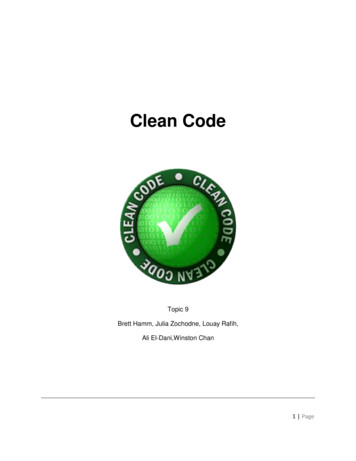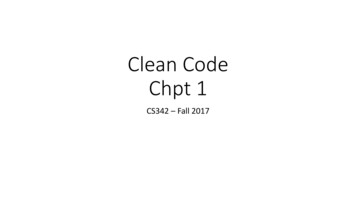
Transcription
Clean CodeTopic 9Brett Hamm, Julia Zochodne, Louay Rafih,Ali El-Dani,Winston Chan1 Page
CONTENTSAbstract . 3Common Aspects of Bad Code . 4Common Effects of Bad Code onto Applications and Customers. 6Writing Code that is Easily Understood . 7Writing Code that is Testable . 9Writing Code that is Maintainable . 10Writing Code that is Reusable . 11Code Refactoring. 12Code Refactoring Strategies . 12Approaches to Refactoring. 13Code Refactoring Example . 15Code Refactoring Tools . 19Conclusion . 20References . 212 Page
ABSTRACTClean code refers to the quality of software, usually pertaining to the readability andunderstandability of source code. We wouldn’t be where we are today without continuallyimproving the quality of software using refactoring. One main reason for refactoring ismaintainability. It is much easier to fix bugs in code when people can actually understand it, andlocate things in a timely manner. Another major reason for refactoring code is to increase theextensibility of the software. It is much easier to extend the capabilities of an application throughthe use of well-structured design patterns, and provides another level of flexibility.It is said that beauty is in the eye of the beholder. In some sense, the same can be said aboutclean code. An experienced programmer can easily spot unreadable source code. People alsodevelop separate opinions on whether or not code is efficient, simple, or well structured. However,most programmers can probably agree on whether a piece of code is clean or not.Although there are many factors contributing to clean code, some are universal and apply toany domain or programming language, while others are specific to the task at hand. In this paper,we will focus on general code refactoring techniques that do not change the functionality of thecode, but change its structure and usability. These techniques can be used in any range of softwareand or scripting applications.3 Page
COMMON ASPECTS OF BAD CODEIn order to write cleaner code it is first necessary to recognize signs of bad code. We will begin withsome of the more obvious features of bad code, which are often described as having a bad smell. Wecan define a code smell as an indication that there are problems with the quality of the source code(Atwood, 2006). The following basic code smells are some of the most general and apply to mostprogramming languages.Code duplication is an indication of poor quality code. It indicates that the design of the software isnot sufficiently modular (McConnell, 2004). Duplication can be easily spotted with code that is identical.It can also occur when similar steps are used in code that appears to be different. Duplication alsoresults in code that is more difficult to modify and maintain (McConnell, 2004). If changes need to bemade to code that is duplicated, corrections have to be applied in multiple places, which increases theprobability for mistakes.The use of very long functions is another common aspect of foul smelling code. Functions that arehundreds of lines long are more difficult to understand and more difficult to debug (Atwood, 2006). It ismore difficult to keep track of local variables that appear in very long functions as they may not havebeen used for hundreds of lines!A similar issue is the use of functions with a long list of parameters. The complexity of a functionincreases with the number of parameters, which both increases the coupling of the code and decreasesits understandability (Atwood, 2006).There are further smells specific to object oriented programming. These are particularly relevant asmany of us spend a significant amount of time programming using the object oriented paradigm.A class that lacks cohesion, or that takes on a variety of unrelated responsibilities, is a code smell. Itencounters the same issue as very long functions as it is more difficult to understand and to debug, andshould be broken down into smaller more cohesive classes (McConnell, 2004).It is also a code smell if classes are overly intimate with one another, that is, they expose too muchinformation to one another (McConnell, 2004). A lack of information hiding means that the code is morecomplex. Also, if classes are overly dependent on one another the program becomes less robust andmore difficult to modify or extend.4 Page
For similar reasons, a class with many public data members is a code smell: it also violates theprinciple of information hiding and make code more complex and less flexible.These are only a few examples of code smells. These can be used as part of a more extensive checklistwhen deciding whether or not to refactor code.5 Page
COMMON EFFECTS OF BAD CODE ONTO APPLICATIONS ANDCUSTOMERSWe have already considered some aspects of bad code from the programmer’s perspective. Theseare indications of internal code quality visible only to the programmer. However, we will now discusssome symptoms of bad code from the point of view of the application. These are external symptomsthat a customer would actually be able to observe. Some characteristics of external software qualityinclude obvious positive qualities such as correctness and usability, as well as characteristics such asadaptability and robustness (McConnell, 2004).It is easy to see how bad code that is difficult to maintain and understand might lead to anincreased number of software defects – programmers may take longer to find and correct defects in badcode (McConnell, 2004). This in turn impairs the correctness and reliability of the software from acustomer’s perspective. Similarly, code that is rigid and not easily changed from the programmer’sperspective can result in an application that is less adaptable to different environments and lessadaptable to a customer’s requests (McConnell, 2004).6 Page
WRITING CODE THAT IS EASILY UNDERSTOODEverything in software contains names of variables, functions, arguments, and classes. Sinceeverything is named, we need to name things so that it is easy to understand. To help understand whata function, variable or class does, the name should have a meaning or be descriptive. If a name is notdescriptive, for example variable int d, then then it is not considered a good name. Proper naming willmake it easier to understand, debug, maintain and change code. An example of naming variablesproperly is:1.) incomePerMonth over ipm2.) circleRadius over crA simple guideline to follow when naming variables is to begin with a lowercase and use camelcase. Constants should use all capital letters and underscores. One of the reasons for naming constantswith all capitals is so that it can easily be located in a body of text. Classes should have a noun thatrepresents the class, and should not consist of a verb. A method should consist of a verb that starts witha lowercase letter and use camel case. You should make sure that names do not vary in small ways toavoid confusion. For example handlingParsingOfString vs handlingParsingOfStringToInt, orgetTreatment(), getTreatments() and getTreatmentInfo. Names should also not consist of a single letter,because this will make it difficult to search for in your code body. One exception to this guideline isusing single letter local variables inside short methods. Another part of clean code is to pick one wordfor a concept. An example of what not to have is to use stop, stay, halt, pause, and freeze for a singleconcept. Functions should be small, so that it can be easily understood and should only do onething. The purpose of small functions is to shorten larger chunks of code that can complicate andconfuse someone reading the code.When reading code, comments can help us understand what is happening. They should be used tomake sense of code that is hard to describe with naming alone. However, comments can also be uselessand misleading. For example, they can be used as an attempt to explain poorly written code. If amethod or function is confusing and badly written, it is better to re-write the code rather than only adda comment. Clean code with few comments is better than complex code that is not easilyunderstood. Code should explain what is being done, and comments should explain why. Commentsshould not restate code, as this is redundant. An example of this is “int count 1 //set count to1.” Each method should be documented with its inputs, outputs and side effects. This is a made upexample :/** Description of aRandomMethod(int aNumber, int bNumber)** @param aNumberDescription of aNumber* @param bNumberDescription of bNumber* @returnDescription of a return value*/7 Page
Another part of good commenting practice is to not have commented out code. It will raisequestions as to why it is commented out and if it is important or not. It is better to delete code, as mostsoftware development uses source control that will remember the code. Changes can be reverted backtoo, and the code will not be lost should you require it in the future. The reason for having clean codeis because it is the only part of software that describes accurate information.When formatting code, you need to watch your whitespace and indenting. The purpose ofwhitespace is to make it easier to read. Logic can be separated by blank lines. An example of spacing is“for(int i 0;i N;i ) vs.for (int i 0; i N; i ) “(Princeton University, 2013).In the example above, it is easier to read the right hand side than the left hand side. The left handside seems more cluttered. A rule to follow is to space after a comma or after a statement. As this is upto the programmer, it should be made legible. Some rules for indenting are:1.) Avoid lines longer than 80 characters2.) Wrap your lines(Princeton University, 2013).An example of proper indenting:“//DON'T USE THIS INDENTATIONif ((condition1 && condition2) (condition3 && condition4) !(condition5 && condition6)) { //BAD WRAPSdoSomethingAboutIt();//MAKE THIS LINE EASY TO MISS}//USE THIS INDENTATION INSTEADif ((condition1 && condition2) (condition3 && condition4) !(condition5 && condition6)) {doSomethingAboutIt();}”(Oracle, 2006).8 Page
WRITING CODE THAT IS TESTABLEApart from writing that code that is easy to understand, code should also be testable. Test drivendevelopment and unit testing are important parts of agile software development. Tests are importantbecause it helps you understand your program and reduces the code complexity. It can also help yourealize what effect code changes have on specific parts of your software.Unit tests examine parts of your code. Code that is easy to test should be loosely coupled, meaningits components have little or no knowledge of other separate components. Code should also separatelogic from factories. Logic consists of declarative statements, while factories are objects that createother objects. The factories are full of new operators that build objects, while the logic does not containany new operators. Tests focus on the application logic, and if this part is separate, it is easier totest. Code should be asking for things instead of searching:“If you are a House class then in your constructor you will ask for the Kitchen, LivingRoom, andBedRoom, you will not call the "new" operator on those classes (see 1). Only ask for things youdirectly need,” (Google blog, 2008).And also “If you are a CarEngine, don't ask for FuelTank, only ask for Fuel” (Google Blog, 2008).Code in the constructor should not have the constructor doing many different things. It should be forinstantiating an object and any of its dependencies. This makes testing easier because, in theconstructor, you do not want to navigate through every instance you create for a certain propertybecause it can be complex. If you have multiple instances of an object and that object has a variable,you want to make sure that variable is not global. This is because the point of testing is to test individualparts and global variables would persist through all tests.9 Page
WRITING CODE THAT IS MAINTAINABLEMaintainability of code is an important issue every application faces. It defines the speedand ease of which developers can read, understand, and modify code. Code maintenance can bedivided into four categories. These categories are corrective maintenance, preventive maintenance,predictive maintenance, and maintenance prevention (Blanchard, Benjamin and Verma, 1995).Corrective maintenance includes cases of unscheduled maintenance after a system failure.This is a category that developers try to avoid by developing a well-structured design. However, inmost cases this does not happen, meaning that the majority of maintenance problems fall under thiscategory.Preventive maintenance is when scheduled maintenance is performed to prevent futurefailures. Larger systems spend large amounts of time and money in this category to ensure theirusers do not experience failures (Blanchard, Benjamin and Verma, 1995).Predictive maintenance is the process of monitoring equipment to evaluate their status, sothat any degradation noticed can be quickly maintained (Blanchard, Benjamin and Verma, 1995).Maintenance prevention is the practice of minimizing maintenance downtime andrequirements for support resources. These four categories emphasize the four types ofmaintenance that a system can undergo (Blanchard, Benjamin and Verma, 1995).There is a close connection between clean code and maintainability. Developers constantlyuse the acronym KISS (Keep It Simple Stupid), because having code that is too complex to read oreven understand hinders the ability of other developers to correct the failure. Correctivemaintenance is always a problem for companies as “A system that is expensive or risky to change isan opportunity to cost your business” (Miller, 2006). Although it is not always possible to developsimple and well-structured code, good naming conventions can make a world of difference.Developers that are knowledgeable about a system should be able to quickly understand thepurpose of certain functionality. Companies realize this issue and are proactive to solve theproblem by performing preventative maintenance.Scheduling maintenance on systems allows companies to constantly extend their systems.Doing so requires a well-structured system that contains the following aspects; documentation,descriptive naming conventions, reducing coupling, and code testing. Scheduled maintenanceallows companies to constantly adapt to the ever-changing market, and allowing relatively fastextensions on already existing systems gives companies the edge. However, constantly addingextensions into poorly maintained code can result into major failures and loss of money. Largersystems are usually developed by large groups of developers, making it difficult to maintainconsistent naming conventions. In order to avoid these problems, development standards are putshould be put into place to help prevent inconsistency.10 Page
The most important aspect that may be overlooked in a system is code testing. Code testingcan quickly identify if changes to the system can cause errors. To safeguard changes into thesystem, companies implement testing frameworks that can quickly identify failures. In addition towriting maintainable code, it is also important to write maintainable test cases. Ever-changing codemeans ever-changing test cases. Following the same standards as code conventions, test casesshould also be easily understood and adaptable.Clean code and maintainable code go hand in hand, as developing code makes it easier forthe developer to perform maintenance. The two categories described above define the majorinstances of maintenance systems can have, and can simply defines how well a system ismaintained based on what type of maintenance a system undertakes.WRITING CODE THAT IS REUSABLECode reusability is an essential component in software development. It allows for teams ofdevelopers to work together on highly complex applications while keeping their code organized.Code encapsulation is a process that allows developers to bundle functionality into related classes,while at the same time hiding other functionality that should not be visible to outside tasks. This issimilar to reusable code because code should be stored in a location where it is accessibleanywhere in the application. However, if the application is too complex, the code should be furthersub-divided to ensure code is not repeated in multiple classes. Code that is repeated in multipleplaces in the application defeats the purpose of reusability. In addition to adding unnecessary code,it also makes tasks such as maintaining code more time consuming and expensive. Reusable codealso makes the application extensible, as the code is well organized and easy to maintain. Thereusability of code can simplify the structure of code, and is just one more step used by developersto create clean code.Separating business logic from generic utility classes, which only contain tasks that are required bythe system, is a fundamental step for creating reusable code. Although separating the business logicfrom the utility classes is important, it is also vital to understand the code. If a number of tasks aredependent on a section of reusable code (Ausnit-Hood et al. 1995), the code must be easilyunderstood and changed accordingly. In addition, the code must also be independent so thatunnecessary major refactoring is avoided. To avoid major refactoring developers must constructcode to only adopt necessary information from other parts of the application that use it. Otherwise,the complexity of the code will make it difficult to be reusable as well as maintainable. Complexityin reusable code can result in fatal errors that can have far reaching consequences, therefore, codethat will be reused must be of the highest possible quality.11 Page
CODE REFACTORINGRefactoring is prevalent in many aspects of software development. It occurs duringapplication development, extension and maintenance. However, time constraints and codecomplexity often present barriers to refactoring.There has to be a comprehensive understanding of the design, such that introducing newerrors would be minimized. However, every software project has time constraints to whichdevelopers must abide by, so refactoring may not be possible. A project is typically paid for addingnew features, not fixing something that is not broken. Consequences of not refactoring include thedegradation of the design of the software. Code becomes more brittle and changes to the system aremore expensive and frequent. In this excerpt, we will go over strategies and tools involved in coderefactoring with examples to help visualise the concepts.CODE REFACTORING STRATEGIESCode refactoring is meant to preserve the behaviour of the system. Refactoring strategiesfollowing an arithmetic learning style and expect unit tests to occur after major/minor refactoring.This section will go over bad coding and refactoring strategies that can be used to alleviate the badcode.With duplicate code, any changes made to one set must be made on all duplicates and thedeveloper maintaining this duplicate code must be aware of all occurrences of it. To fix duplicatecode, you can either push identical methods or the more general method up to a commonsuperclass, or put the method into a common component that can be accessed by all who requirethe code. This also reduces the size of larger methods/classes as the code in larger methods andclasses can be parsed into smaller methods and sub-components. Thus, these components andmethods can be used more generally than their larger affiliates.12 Page
There are issues with instance variables where some classes would never use them and onthe opposite end, co-occurring parameters are commonly seen. A set of co-occurring parameterswould be something like (x-coordinate, y-coordinate). To handle instance variables, subclasses canbe created that entail the instance variables that cover a high percentage of methods that wouldneed them. To fix co-occurring parameters, it is basically the same approach where the creation ofthe class is specifically meant to entail those parameters (Point). Thus, the classes can handle anybehaviour for the set.APPROACHES TO REFACTORINGEXTEND - REFACTORExtend – Refactor is finding a similar class/method and making it work for the extension.Once the class/method is working, eliminate any redundancies that occurred during theimplementation of this new method (Wake, 2013).REFACTOR - EXTENDRefactor-Extend considers the design of the system with the new extension. If it feels thatthis extension is not suited to fit well in the design, then there must be a refactor process to make itso the extension would be implemented easily (Wake, 2013).DEBUG - REFACTORDebug - Refactor is meant to handle a bug, thus the behaviour of the system would change.Following debugging, refactoring would then proceed to make future bugs more obvious byextracting large methods, assigning names that describe the variable and getting rid of magicnumbers and expressions (Wake, 2013).REFACTOR - DEBUG13 Page
Refactoring first should preserve the behaviour of the system, so in this case it wouldpreserve bad behaviour. It would also simplify complicated methods if done right, which makes iteasier to debug the program (Wake, 2013).REFACTORING TO UNDERSTANDRefactoring in this case is to make the code readable to many developers rather than justthe author. Performance and extensibility is also disregarded somewhat with this strategy. A bigissue with refactoring to understand is that naming conventions or logical operations may only beobvious to the author. Common tasks involved with refactoring to understand are breaking apartlarge methods, removing magic numbers/expressions and descriptive variable/method/classnames (Wake, 2013).As there are no extensions being implemented or bug fixed using this refactoring strategy, itis not usually obvious to people outside the development team why there is time allocated to thisprocess (Wake, 2013).14 Page
CODE REFACTORING EXAMPLEA sample code refactoring will now be done on the following piece of code. We will be excludingunit tests from this example to keep it short, but it is imperative that unit tests are done andsuccessful after each refactoring (Yoder, 2002):public class CodeReplacer {public final String TEMPLATE DIR "templatedir";String sourceTemplate;String code;String altcode;//This method was created in VisualAge.// @param reqId java.lang.String// @param oStream java.io.OutputStream// @exception java.io.IOException The exception description.public void substitute(String reqId, PrintWriter out) throws IOException{// Read in the template fileString templateDir System.getProperty(TEMPLATE DIR, "");StringBuffer sb new StringBuffer("");try {FileReader fr new FileReader(templateDir "template.html");BufferedReader br new BufferedReader(fr);String line;while(((line br.readLine())! "")&&line! null) sb new StringBuffer(sb line "\n");br.close();fr.close();} catch (Exception e) {}sourceTemplate new String(sb);try {String template new String(sourceTemplate);// Substitute for %CODE%int templateSplitBegin template.indexOf("%CODE%");int templateSplitEnd templateSplitBegin 6;String templatePartOne new String(template.substring(0, templateSplitBegin));String templatePartTwo new String(template.substring(templateSplitEnd, template.length()));code new String(reqId);template new String(templatePartOne code templatePartTwo);// Substitute for %ALTCODE%templateSplitBegin template.indexOf("%ALTCODE%");templateSplitEnd templateSplitBegin 9;templatePartOne new String(template.substring(0, templateSplitBegin));templatePartTwo new String(template.substring(templateSplitEnd, template.length()));altcode code.substring(0,5) "-" code.substring(5,8);out.print(templatePartOne altcode templatePartTwo);} catch (Exception e) {System.out.println("Error in substitute()");}out.flush();out.close();}}15 Page
The code shown currently is working code that generates a web page by substituting stringsin a template read from a file. Right now it shows that there are too many strings created astemporaries.Now that we have code that is in need of refactoring, we must identify the smells of thispiece of code. The most noticeable is the length of the substitute() method, so using Extract Method(Note, capitalization of the method is referencing the refactoring.com catalog) to break the largesubstitute() into smaller methods. The most obvious breaks would be where the comments are inthe middle of the code. Here is the new readTemplate(), substituteForCode andsubstituteForAltcode() (Yoder, 2002):String readTemplate() {String templateDir System.getProperty(TEMPLATE DIR, "");StringBuffer sb new StringBuffer("");try {FileReader fr new FileReader(templateDir "template.html");BufferedReader br new BufferedReader(fr);String line;while(((line br.readLine())! "")&&line! null) sb new StringBuffer(sb line "\n");br.close();fr.close();} catch (Exception e) {}sourceTemplate new String(sb);return sourceTemplate;}String substituteForCode(String template, String reqId) {int templateSplitBegin template.indexOf("%CODE%");int templateSplitEnd templateSplitBegin 6;String templatePartOne new String(template.substring(0, templateSplitBegin));String templatePartTwo new String(template.substring(templateSplitEnd, template.length()));code new String(reqId);template new String(templatePartOne code templatePartTwo);return template;}void substituteForAltcode(String template, String code, PrintWriter out) {String pattern "%ALTCODE%";int templateSplitBegin template.indexOf(pattern);int templateSplitEnd templateSplitBegin pattern.length();String templatePartOne template.substring(0, templateSplitBegin);String templatePartTwo template.substring(templateSplitEnd, template.length());altcode code.substring(0,5) "-" code.substring(5,8);out.print(templatePartOne altcode templatePartTwo);}16 Page
Now that these methods have been added, the substitute() method is much smaller than theinitial code. There is still refactoring needed to be done on the smaller methods though. InreadTemplate(), Introduce Explaining Variable will be used to replace “templateDir” with:String templateDir System.getProperty(TEMPLATE DIR, "") “template.html”;Also, using Inline Temp, we realise that “fr” is not needed:BufferedReader br null; br new BufferedReader(newFileReader(templateName));We need to surround the function with a try/catch block to properly close the stream in case of anyerrors:try {.} catch (Exception ex) {} finally {if (br ! null) try {br.close();} catch (IOException ioe ignored) {}}Inside the while loop, there is a constant initialization of a string that is not needed (Replace StringWith StringBuffer):sb.append(line);sb.append('\n');Once all these refactorings have been completed, we can move on to substituteForAltcode() andsubstituteForCode(). These two functions have the same coding logic with two differentparameters. It would be simple to add two parameters to a method and name itsubstituteCode()(Yoder, 2002):void substituteCode (String template, String pattern, String replacement, Writer out)throws IOException {int templateSplitBegin template.indexOf(pattern);int templateSplitEnd templateSplitBegin pattern.length();out.write(template.substring(0, ite(template.substring(templateSplitEnd, template.length()));out.flush();}17 Page
With all these changes, you would then handle errors and refactor tests appropriately to come tothe final result (Yoder, 2002):import java.io.*;import java.util.*;/* Replace %CODE% with requested id, and %ALTCODE% with "dashed" version of id. */public class CodeReplacer {String sourceTemplate;public CodeReplacer(Reader reader) throws IOException {
clean code. An experienced programmer can easily spot unreadable source code. People also develop separate opinions on whether or not code is efficient, simple, or well structured. However, most programmers can probably agree on whether a piece o











